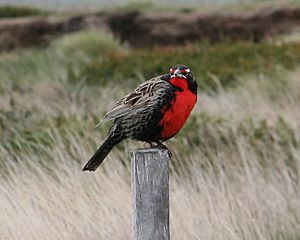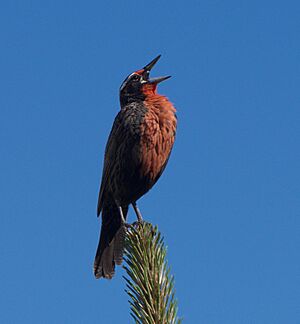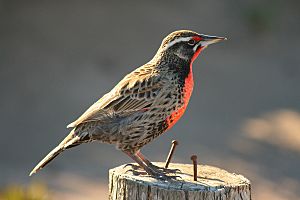Long-tailed meadowlark facts for kids
Quick facts for kids Long-tailed meadowlark |
|
|---|---|
 |
|
| Conservation status | |
| Scientific classification | |
| Synonyms | |
|
Sturnella loyca |
The long-tailed meadowlark (Leistes loyca) is a colorful bird found in southern South America and the Falkland Islands. It belongs to a group of birds called meadowlarks. This bird looks a lot like its cousin, the Pampas meadowlark.
Contents
What Does the Long-tailed Meadowlark Look Like?
This bird is about 25 to 28 centimeters (10 to 11 inches) long. It has a fairly long tail and a pointed beak.
Male long-tailed meadowlarks are mostly dark brown. They have black stripes on their bodies. Their chest and throat are a bright, fiery red! They also have a white spot on their face near their beak. A bold white stripe goes over their eye, turning red in front of it.
Female long-tailed meadowlarks are a bit lighter in color than the males. Their red markings are mostly on their belly. The stripe over their eye and their throat are a soft, yellowish-brown color.
Where Do Long-tailed Meadowlarks Live?
Long-tailed meadowlarks breed in southern Chile and parts of Argentina. When winter comes, some of these birds fly north to warmer places.
There's a special type of long-tailed meadowlark found only in the Falkland Islands. It's called L. loyca falklandica. People on the Falkland Islands call it the "military starling."
These birds love open spaces. You can find them in grasslands and similar areas. They spend their time on the ground, looking for food.
What Do Long-tailed Meadowlarks Eat?
Long-tailed meadowlarks mainly eat invertebrates. This means they munch on small creatures like insects and worms. They are good at finding these tasty snacks on the ground.
Life Cycle and Reproduction
The female long-tailed meadowlark builds the nest. She uses dry grass to make a cozy home. The nest is usually placed on the ground or very close to it, hidden among the tall grass.
When the female leaves her nest, she is very clever! She walks a few meters away, hiding in the dry grass. This trick helps keep predators from finding her nest. She uses the same method when she returns. She lands a bit away from the nest and then walks to it.
During the breeding season, a female will lay two sets of eggs. Each set usually has two to four eggs. The eggs are a pretty bluish-white color. They have dark spots and streaks on them.
See also
 In Spanish: Loica común para niños
In Spanish: Loica común para niños




